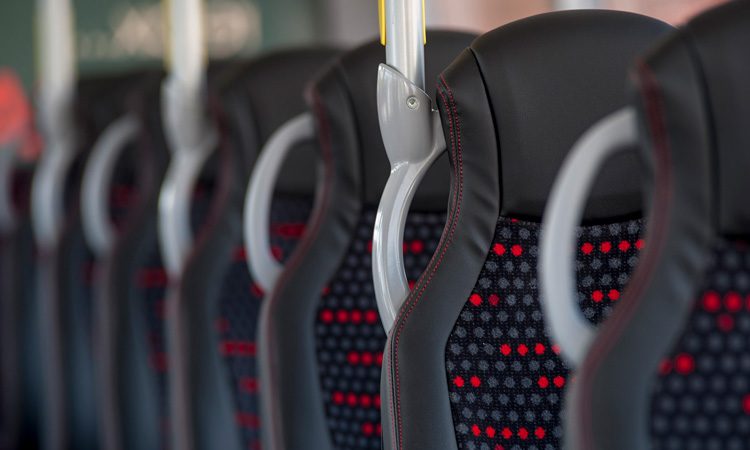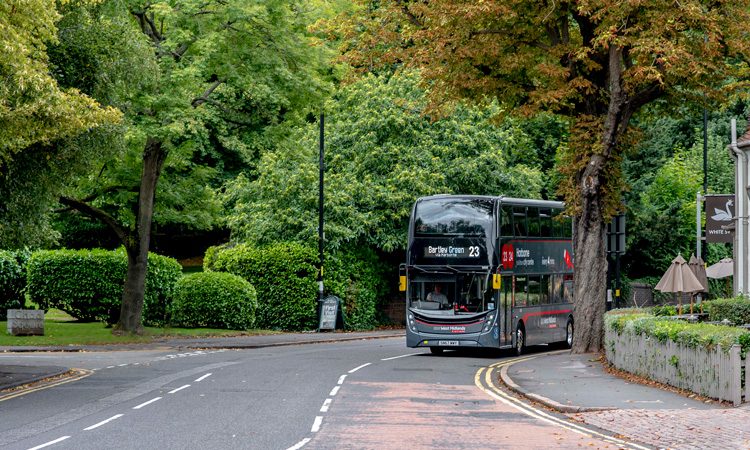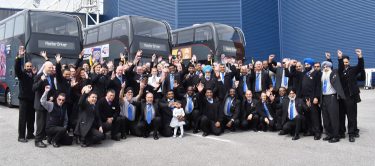Passenger satisfaction and insight via innovation and investment
- Like
- Digg
- Del
- Tumblr
- VKontakte
- Buffer
- Love This
- Odnoklassniki
- Meneame
- Blogger
- Amazon
- Yahoo Mail
- Gmail
- AOL
- Newsvine
- HackerNews
- Evernote
- MySpace
- Mail.ru
- Viadeo
- Line
- Comments
- Yummly
- SMS
- Viber
- Telegram
- Subscribe
- Skype
- Facebook Messenger
- Kakao
- LiveJournal
- Yammer
- Edgar
- Fintel
- Mix
- Instapaper
- Copy Link
Posted: 10 December 2019 | Adam Rideout - National Express Bus | No comments yet
Adam Rideout, Head of Customer Experience at National Express Bus, tells Intelligent Transport how the West Midlands bus operator is investing in people and technology to enhance the passenger experience and make travel as seamless as possible for both frequent and infrequent bus users.


What areas is National Express Bus investing in to improve passenger experience?
We can’t plan effectively unless we know what our customers want. It can be easy to get caught up in small details that don’t matter to customers; understanding what they want is the main thing we have to do before we make any kind of investment.
Drivers are the key point for customers – having friendly interactions is massively important and is the key difference between being good and great. From our point of view, safety is paramount; the backbone of our business is ensuring that it is run safely for both our passengers and our staff.
One initiative we’re running on the driver side is called Driver Oversight, a risk management process that allows us to assess drivers on quality and standards, considering speed data, customer complaints and other factors to constantly score drivers in their depots and then across the business. It gives us visibility of how our drivers are performing so we can not only monitor service quality and safety, but also offer help to those that need it. We particularly focus on new drivers because they need and like that extra support at the beginning of their time with us.
Another investment we’ve made in our drivers to encourage them to help make the customer experience better and safer is our Master Driver programme, which offers them career progression – a key factor in retaining the best
One of the systems we use for this monitoring is DriveCam, which is on all our buses. The system monitors reaction times and records events to gather information that we can use to demonstrate how things can be done differently. We’re able to use that kind of information to judge why an incident occurred: if a passenger falls over, did it happen because the bus pulled away too quickly? DriveCam has been something of a revelation, not only for safety, but for schedulers too. It gives them a better idea of what drivers can and can’t do in a safe way, especially with regard to speed. Being able to monitor driver behaviour consistently on a certain part of a route enables us to better timetable our journeys.
Another investment we’ve made in our drivers to encourage them to help make the customer experience better and safer is our Master Driver programme, which offers them career progression – a key factor in retaining the best. There are three tiers to being a driver: professional drivers, who join the company and start driving for us; advanced drivers, who have two years of no accidents and have to pass tests to achieve this level; and master drivers, which is a much more critical assessment. Master drivers have to be accident-free for three years, but we also consider their customer complaint record, DriveCam statistics, analytics and a number of other stretching factors. We’re proud to have a growing number of drivers in every depot that have qualified as master drivers.
We’re also continuing to make huge investments on board new vehicles – we’ve replaced 10 per cent of our entire fleet in the last 12 months. When we’re investing in vehicles, we want to make sure they’re high quality. We introduced our premium Platinum buses four years ago with Wi-Fi, extra leg room and high-backed, partially leather seats – now there’s also USB charging and next stop announcements. Research has told us that passengers value the on-board environment and comfort very highly – we have to make the bus a viable alternative to the modern car.
We’re also retrofitting vehicles to ensure they are compliant with Birmingham’s new clean air zone (CAZ), which is being introduced in July 2020. We will be CAZ-ready by January 2020, having ensured that alongside our retrofitting efforts, all new vehicles purchased in the last three years meet the super-clean Euro VI standard.
Elsewhere, we’re investing quite heavily in our digital platforms. We have a ticketing app and a ‘next bus’ app which we’re combining to make the planning and buying stages of the customer journey as seamless as possible. For the B2B market we have launched a number of web ticketing portals so that colleges and businesses can transact with us seamlessly.
What impact does technology like contactless payment have on bus users?
In the West Midlands we’re quite unique in our approach to contactless; similar to London, there are no tickets necessary. Investing in contactless is all about improving boarding times because the on-the-ground infrastructure is very much designed for single door services.
Contactless is so simple and, with time, adoption will grow and people will come to trust it; we know this will make buses more appealing to more people.
Our contactless customers are those that use buses more infrequently or are visitors. Historically, we have run services on an exact fare system and there’s still a pre-conception from infrequent bus users that they need to have the exact change to be able to travel. That’s not the case with contactless as an option; bus travel is now more accessible in terms of payment than it’s ever been.
We are looking at introducing weekly capping or perhaps zonal fares, but it’s something we’ll need to research carefully. We don’t have fare zones like the London Underground, but we do have low-fare zones, in the Walsall area for example. Tapping on every bus you get on, if you only use buses in Walsall, you’ll be charged a lower daily rate than if you use buses across the network.


With real-time information becoming ubiquitous, how do operators tackle the next trend in information provision; personalisation?
I think there’s still work to be done educating our customers and the general public more broadly on real-time information. Personalisation is the new trend for the industry, but there are still significant numbers of customers that don’t understand that real-time information and apps can help them plan their lives and their time better.
We’re currently running a bus fitted with facial recognition technology as a ‘test and learn trial’. This not only enables passenger counting, it also provides us with better information about where passengers are getting on and off the bus
We get complaints from customers saying that they were waiting for a specific bus and it was five minutes late and they feel put out. Like every bus company, we register our services with the traffic commissioner and we have to run those services – that’s our promise. Factors like inconsistent traffic volumes and roadworks are headwinds against us fulfilling that promise, but, naturally, our passengers don’t see it that way – they just want their bus to turn up on time.
The key thing is what ‘on time’ means. We want to help passengers understand that on time doesn’t necessarily mean that the 18:31 bus will turn up at exactly 18:31 – it’s about giving them the knowledge that they can turn up at the bus stop and a bus will be coming in three or four minutes; it’s then irrelevant if that bus is a little bit later than scheduled.
How we personalise real-time information, journey planning and fares comes next, but the key question we have to ask ourselves is whether customers want transport providers to do it. We want to have a relationship with our customers, but do they want one with us? Is there a way to customise information without knowing the customer? Push notifications for our app are part of the development roadmap and they could help with this. The app (and/or other digital platforms) would need to learn which services users are looking at and using most frequently and send push notifications accordingly, eventually advising on ticket types and disruptions.
How do on-board technologies, for example passenger counters, help to collect data that can in turn be used to improve passenger experience?
We’re currently running a bus fitted with facial recognition technology as a ‘test and learn’ trial. This not only enables passenger counting, it also provides us with better information about where passengers are getting on and off the bus. Currently, we can only predict that kind of information, but facial recognition will help inform what kind of people we’re carrying, where they’re boarding and alighting, and, looking ahead, it will help with personalisation.
This technology will enable us to predict seating capacity and push the information to customers waiting at bus stops. It will also help inform Transport for West Midlands (TfWM) and their investment decisions, for example in the case of on-street furniture. As an example in the West Midlands, there are bus stops in places that never get used because the factories they were put there to serve have closed.


The latest group of master drivers celebrate success
Counting technologies could not only help shape investment decisions but also help us to better plan our routes. The bus industry needs to become more dynamic and take people where they want to go as simply and as seamlessly as possible. New technology has created huge opportunities to win new customers, but we need to show those potential new customers that the bus isn’t old fashioned and can keep up with some of the new challengers in the market.
Is there a significant next step that could transform the passenger experience, or is there more likely to be a continuation of the advancements we’re currently seeing?
I expect to see the industry constantly moving forward but at an ever-increasing pace. In my opinion, one of the most pivotal aspects of this would be dynamic scheduling; will the bus industry ever reach the point where it doesn’t have to entirely commit to running buses at specific times? A more dynamic approach would allow us to tackle congestion and challenge the competition. Currently, it’s difficult to update timetables to fit around traffic because it ends up being too confusing for passengers; we are running in a modern, demanding world with an old, restrictive approach.
Making payment as simple and as logical as possible is also key. Eventually, passengers will get to a point where they’re no longer happy paying for a weekly pass they might only use a couple of times through no fault of their own. It’s not a pricing model that’s really accepted in any other industry, so why should customers accept it just because “it has always been like that”?
Personalisation is the new trend for the industry, but there are still significant numbers of customers that don’t understand that real-time information and apps can help them plan their lives and their time better
This industry has a big future, but it needs to adapt quicker to the ever-changing expectations that people now have. The bus sector has the answer to so many mobility and environmental challenges, but it needs to prove to stakeholders and passengers that it’s worthy of taking that mantel on.
Biography
Adam Rideout has been working in the bus industry for 18 years. He is currently Head of Customer Experience at Birmingham-based National Express Bus. After university, he started his career in Oxford working for local bus operator Stagecoach. Over the course of 10 years, he took up various marketing roles at other Stagecoach companies across the UK. In 2012 he moved to National Express’ UK Bus division as Head of Marketing and in late 2015 became Head of Customer Experience.
Related topics
Fleet Management & Maintenance, Journey Planning, Mobility Services, Passenger Accessibility, Passenger Experience, Public Transport
Issue
Issue 3 2019
Related modes
Bus & Coach
Related organisations
National Express Bus








